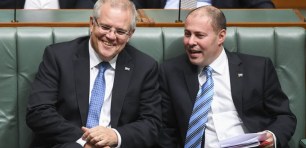
Prime Minister Scott Morrison. Source: AAP/Lukas Coch.
Small businesses are set to benefit from a $1.2 billion boost to the government’s digital economy strategy that will include changes to the tax treatment of intangible assets, access to digital technology advice and funding to accelerate the take up of e-invoicing.
Prime Minister Scott Morrison today announced the increase in spending ahead of the May 11 budget, saying digital transformation in Australia “needs to happen”.
“We must keep our foot on the digital accelerator to secure our economic recovery from COVID-19,” he said.
Changes to intangible assets tax write-offs
As part of the $1.2 billion injection into the national digital economy strategy, $170 million will be allocated to overhaul the tax treatment of intangible assets.
The change will give intangible assets, including in-house software and intellectual property, the same treatment as tangible assets by allowing taxpayers to self-assess the life of an asset.
The change will kick in when the current temporary full expensing measures and instant asset write-offs for eligible businesses expire on 30 June 2022.
Ian Yip, chief executive of cybersecurity software company Avertro, says the intangible tax write-offs will be helpful, given most of his company’s assets are digital.
“It will help our financial situation,” Yip tells SmartCompany.
“We’re still managing a tough time so any tax support that we can get will help.”
Accelerated e-invoicing plan
Morrison has announced that $15.3 million will be spent to increase the uptake of e-invoicing across the business sector.
SME advisory service
The government will spend $12.7 million on a small business advisory service to help small and medium businesses build their digital capacity.
Digital skills
The package includes $100 million to develop digital skills in the workforce through a new pilot program for work-based digital cadetships and scholarships for up-and-coming tech graduates.
Speeding up AI
The CSIRO will receive $124 billion to build a National Artificial Intelligence Centre supported by a network of AI and digital capability centres, all aimed at accelerating the adoption of AI across the economy.
Digital infrastructure
Additionally, $113 million will be used to expand the rollout of the consumer data right, which allows Australians to control the use of their data by banking and energy companies.
The government will also spend $50 million on cybersecurity services in government, data centres and telecommunications networks.
A further $200.1 million will be spent on myGov in a bid to make it easier for Australians to use the platforms, as well as a $301.8 million investment in My Health Record.
Overall, Yip is supportive of the governments broad focus on digitisation; however, he would have liked to have seen a greater emphasis on the creation of technology rather than adoption.
“I’d like to see more focus on creation and innovation, on helping our Australian companies to create things,” Yip says.
“We want to be world class adopters of tech.”
Handpicked for you

Budget 2021: Depreciation allowances for intangible assets will be a boost to startups and SMEs



COMMENTS
SmartCompany is committed to hosting lively discussions. Help us keep the conversation useful, interesting and welcoming. We aim to publish comments quickly in the interest of promoting robust conversation, but we’re a small team and we deploy filters to protect against legal risk. Occasionally your comment may be held up while it is being reviewed, but we’re working as fast as we can to keep the conversation rolling.
The SmartCompany comment section is members-only content. Please subscribe to leave a comment.
The SmartCompany comment section is members-only content. Please login to leave a comment.